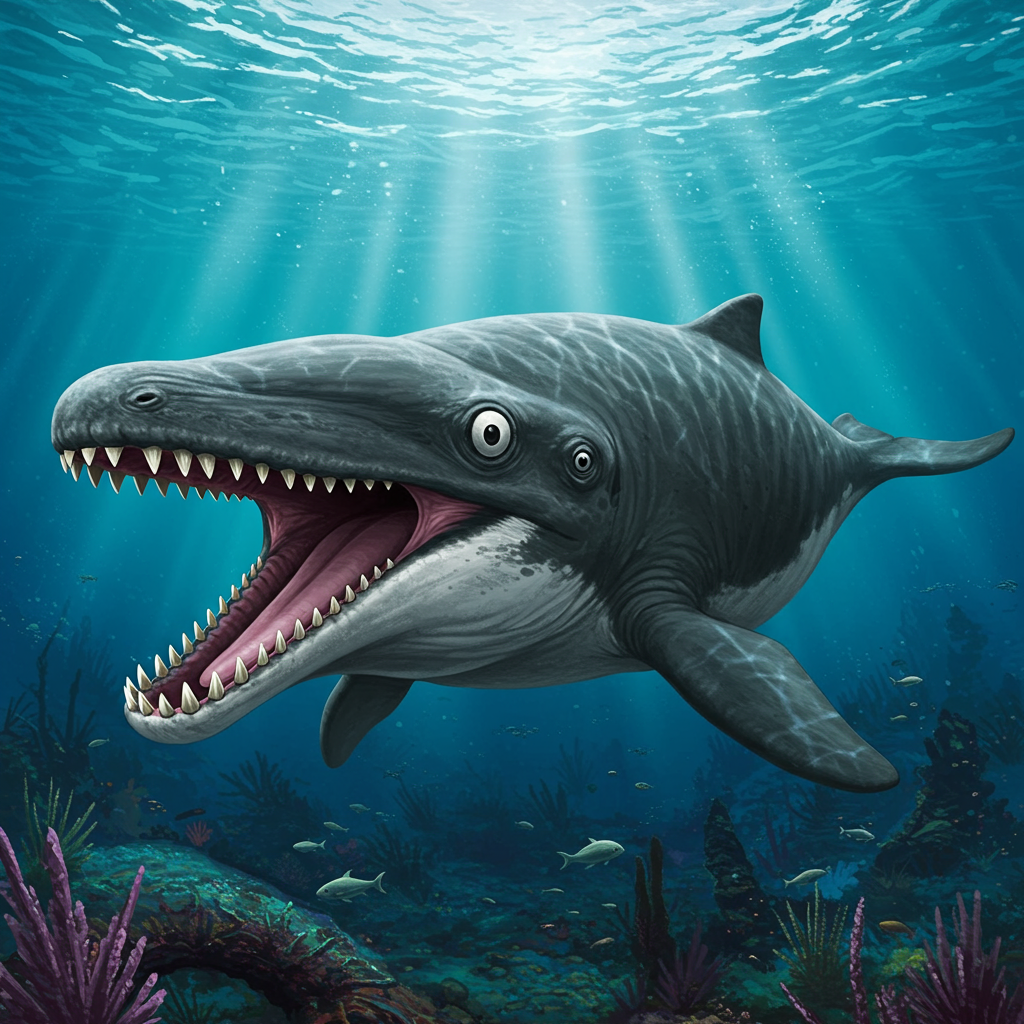A groundbreaking fossil discovery in Australia has unveiled Janjucetus dullardi, a 25-million-year-old ancient whale unlike any modern cetacean. Described as “deceptively cute” yet undoubtedly fearsome, this prehistoric marine predator, with its razor-sharp teeth and large, tennis-ball-sized eyes, is radically reshaping our understanding of baleen whale evolution. Its unique features paint a vivid picture of a fierce hunter thriving in a vibrant prehistoric ocean, prompting scientists to rethink the early stages of cetacean development.
The “Deceptively Cute” Predator: Janjucetus Dullardi’s Unique Features
Imagine a creature the size of a dolphin, yet possessing the predatory prowess of a shark. This describes Janjucetus dullardi, a newly identified species from the Oligocene epoch. Discovered on Victoria’s surf coast, this early whale stood in stark contrast to its closest living relatives: the gentle, filter-feeding baleen whales, which include the largest animals to ever roam Earth. Scientists characterize Janjucetus dullardi as an “oddball of the ocean” – a “weird mash-up between a whale, a seal and a Pokémon.”
A Hunter, Not a Filter Feeder
Unlike today’s majestic blue or humpback whales, Janjucetus dullardi was built for the hunt. It was a fast, sharp-toothed predator, equipped with a short snout and a mouth full of slicing teeth. Dr. Erich Fitzgerald, senior curator of vertebrate palaeontology at Museums Victoria Research Institute, colorfully described it as a “really gnarly whale” he personally “wouldn’t want to get in the water with.” Co-author Ruairidh Duncan from Museums Victoria Research Institute and Monash University added that it was “essentially a little whale with big eyes and a mouth full of sharp, slicing teeth,” like “the shark-like version of a baleen whale – small and deceptively cute, but definitely not harmless.” This portrayal shatters the conventional image of ancient whales as uniformly evolving towards filter-feeding.
Eyes, Teeth, and Skull: Built for the Hunt
The fossilized remains of Janjucetus dullardi reveal extraordinary adaptations for predation. Its skull was “heavily built” and “almost over-engineered,” suggesting immense strength. Its relatively large, forward-facing eyes, approaching the size of tennis balls, indicate exceptional vision, crucial for locating and tracking prey in murky ancient waters. The deeply rooted, razor-sharp teeth were specifically designed for gripping and tearing, confirming its role as an active hunter. While the discovered fossil was likely a juvenile, measuring about two to 2.2 meters – small enough to fit on a beach towel – fully grown individuals are estimated to have reached three meters in length. The juvenile status was indicated by wide open root canals, barely worn teeth, and unfused bone connections.
A Glimpse into the Oligocene Epoch
Janjucetus dullardi thrived during the Oligocene epoch, a period roughly 30 to 23 million years ago. This era, halfway between the extinction of the dinosaurs and the present, was a time of significant global warmth and rising sea levels. The environmental conditions in southern Australia, evidenced by tiny plankton fossils from the Jan Juc Formation, were akin to today’s subtropical waters off Queensland’s Coffs Harbour. This provides a crucial context for understanding the creature’s habitat.
Unraveling Whale Evolution
The discovery of Janjucetus dullardi is pivotal for understanding the broader narrative of whale evolution. It represents the fourth known species from a group called mammalodontids, an early offshoot of the baleen whale family tree that existed exclusively during the Oligocene. Professor John Long, a palaeontologist at Flinders University not involved in the study, emphasized that such fossils are vital for tracing the “stages of how they acquired their special characters” to explain the diversification of modern baleen whales. This carnivorous ancestor provides a rare glimpse into the evolutionary steps as early whales transitioned from toothy predators to the immense filter-feeders we know today.
Ancient Australia’s Vibrant Seas
The Oligocene seas of ancient Victoria were bursting with life. Dr. Fitzgerald described an “extraordinary abundance of life,” including various small whales, enormous penguins, and sharks that were often twice the size of today’s great white shark. This vibrant ecosystem, teeming with diverse marine species, marked a “turning point” in the history of ocean life. It was a period that sparked an unprecedented explosion in the diversification of both whales and dolphins, establishing the lineage that would eventually dominate Earth’s oceans. The Victoria region is recognized as a “cradle” for some of the most unusual whale species in history.
The Rare Fossil Find and Its Significance
The fossil of Janjucetus dullardi is considered “exceedingly rare.” It includes a partial skull, an ear bone, and eight crucial teeth. This remarkable preservation allowed scientists to definitively identify it as a new species, confirming its unique place in the cetacean family tree. Such high-quality cetacean fossils are incredibly scarce, making this find particularly valuable. It marks only the third known mammalodontid species from Victoria and the fourth worldwide, and notably, it’s the first to preserve both teeth and inner ear structures in such detail.
Ross Dullard: The Amateur Discovery
The groundbreaking discovery would not have been possible without the keen eye of local resident and school principal Ross Dullard. In June 2019, while walking along a beach near Jan Juc on Victoria’s surf coast, he spotted something unusual protruding from a cliff face. Recognizing the fossil’s scientific potential, Mr. Dullard generously donated it to Museums Victoria for extensive study. In a fitting tribute to his crucial contribution, the new species was officially named Janjucetus dullardi in his honor. This act underscores the invaluable role of citizen scientists in advancing palaeontology.
Palaeontology’s Public Partnership
The story of Ross Dullard highlights a critical aspect of Australian palaeontology: the continuous and vital contribution of the public. Dr. Fitzgerald noted that “world-changing fossils can be found in your own back yard,” emphasizing the potential for anyone to make a significant discovery. Professor Long echoed this sentiment, pointing out Victoria’s “rich fossil heritage” and the possibility of finding fossils from nearly all geological periods if one “knows where to look.” These public collaborations are unlocking new chapters in evolutionary history, with many more stories yet to emerge from Australia’s ancient past.
Impact on Our Understanding of Marine History
The existence of Janjucetus dullardi fundamentally alters our perception of early whale evolution. It was not a direct ancestor to modern baleen whales in terms of feeding strategy but rather an early offshoot, showcasing an evolutionary path distinct from the familiar filter-feeding giants. This discovery confirms that the transition from land mammals to marine leviathans involved diverse and sometimes surprising adaptations, including a formidable predatory phase for some lineages.
Connecting Ancient Predators to Modern Giants
By studying Janjucetus dullardi‘s fossilized ear bones with advanced CT scans, researchers aim to gain deeper insights into how these early whales sensed their environment, aiding their hunting and navigation. This research could illuminate how ancient cetacean species adapted and diversified. The findings from Janjucetus dullardi are literally “rewriting the story of how whales came to rule the oceans, with some surprising plot twists!” as it helps fill in the gaps of how these massive creatures acquired their specialized characteristics over millions of years.
Lessons for a Changing Climate
Beyond its evolutionary significance, the study of Janjucetus dullardi‘s prehistoric habitat offers crucial insights into modern climate challenges. Understanding how ancient marine life evolved and adapted to previously warmer oceans, particularly during the Oligocene epoch’s global warmth, can provide invaluable clues. Scientists can infer how today’s marine ecosystems might respond to current climate change, rising sea levels, and increasing ocean temperatures. This ancient whale, therefore, offers a unique window into both the past and the potential future of our planet’s oceans.
Frequently Asked Questions
What made Janjucetus dullardi so unique compared to modern whales?
Janjucetus dullardi stands out significantly from modern baleen whales primarily due to its predatory nature. Unlike today’s filter-feeding giants, this ancient species, though dolphin-sized, possessed razor-sharp, deeply rooted teeth and large, forward-facing eyes, specifically adapted for gripping and tearing prey. It was a fierce, shark-like hunter, embodying an “oddball” evolutionary path that contrasts sharply with the gentle, plankton-straining behaviors of its contemporary relatives, offering a surprising twist in the story of whale evolution.
Where was the Janjucetus dullardi fossil discovered, and who found it?
The fossil of Janjucetus dullardi was discovered in June 2019 on Victoria’s surf coast in Australia, near Jan Juc. The significant find was made by Ross Dullard, a local resident and school principal. Recognizing its scientific importance, Mr. Dullard generously donated the fossil to Museums Victoria for study, and in honor of his contribution, the new species was named after him. This discovery highlights the critical role amateur fossil hunters play in contributing to palaeontology.
How does the discovery of Janjucetus dullardi impact our understanding of whale evolution and climate change?
The discovery of Janjucetus dullardi significantly impacts our understanding of whale evolution by showcasing an early, predatory offshoot of the baleen whale family tree. It reveals that the evolutionary journey to modern filter-feeding whales was more complex, involving diverse early forms like this formidable hunter. Furthermore, studying Janjucetus dullardi‘s Oligocene habitat, a period of global warmth, offers valuable insights into how ancient marine life adapted to hotter climates. This knowledge can inform predictions about how current marine ecosystems might respond to ongoing climate change and rising ocean temperatures.
Conclusion
The unveiling of Janjucetus dullardi is more than just the discovery of a new ancient whale; it’s a profound revision of our understanding of marine evolutionary history. This “deceptively cute” predator from the Oligocene epoch challenges established narratives, highlighting the diverse and sometimes surprising pathways that life takes. It underscores the immense value of rare fossil finds and the crucial contributions of individuals like Ross Dullard. As scientists continue to explore ancient Victoria’s rich fossil heritage, Janjucetus dullardi stands as a powerful reminder that our oceans hold countless untold stories, offering not only glimpses into the deep past but also vital lessons for our future.




